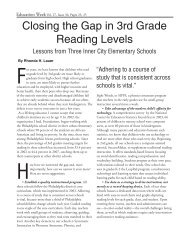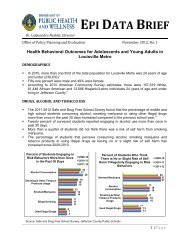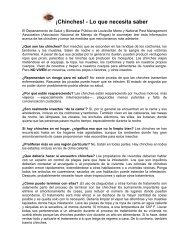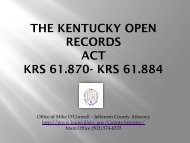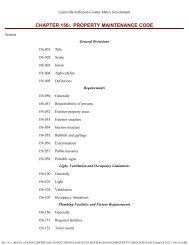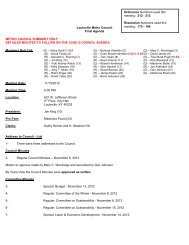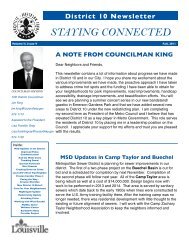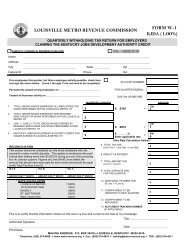Cultural History of Charlie Vettiner Park - Louisville Metro Government
Cultural History of Charlie Vettiner Park - Louisville Metro Government
Cultural History of Charlie Vettiner Park - Louisville Metro Government
You also want an ePaper? Increase the reach of your titles
YUMPU automatically turns print PDFs into web optimized ePapers that Google loves.
Religion<br />
<strong>Cultural</strong> <strong>History</strong> <strong>of</strong> <strong>Charlie</strong> <strong>Vettiner</strong> <strong>Park</strong><br />
Religion was an important facet <strong>of</strong> early settlers‘ lives, although it has been estimated that, prior<br />
to 1800, only 10% <strong>of</strong> citizens actively attended church (Crews 1987:33). Prior to establishing a<br />
church building, area residents <strong>of</strong>ten met at one another‘s homes for service. For many years,<br />
services at home or at the church building were conducted by circuit riders. The oldest<br />
congregation is that <strong>of</strong> the Chenoweth Run Baptist Church, who began meeting at a residence<br />
in 1792 (Jobson 1977). The first building for this congregation was a structure built in 1797 on<br />
land donated to Moses Tyler by William Fleming. This church was located south <strong>of</strong> <strong>Charlie</strong><br />
<strong>Vettiner</strong> <strong>Park</strong> east <strong>of</strong> Billtown Road where Chenoweth Run Cemetery is located. Early members<br />
included the Tyler, Donaldson, White, Freeman, Brant, Applegate, and Seaton families. One<br />
African American, Jack, is reported to have moved from the Cedar Creek Baptist Church in<br />
Nelson County to this one; it was not known if Jack was a freeman or slave (Johnston 1994).<br />
One <strong>of</strong> the earliest cemeteries in the area was established here. John Mundell, who died in<br />
1806, holds the unfortunate distinction <strong>of</strong> being the earliest interment at Chenoweth Run<br />
Cemetery (Johnston 1994).<br />
Over the following 200 years, the Chenoweth Run Baptist Church had many changes, including<br />
a split into two separate churches. During the early nineteenth century, many churches split<br />
during the Great Revival or Second Great Awakening as there were two rival leaders—those<br />
following Thomas Campbell and son Alexander and those following Barton Stone. Issues at the<br />
time included evangelism and constraints imposed by the denominations <strong>of</strong> the time. Those in<br />
the movement sought freedom from human-imposed doctrines and rituals. Followers <strong>of</strong> the<br />
Campbells were known as Campellites or Disciples <strong>of</strong> Christ; those following Stone were known<br />
as Stoneites or New Lights (Restoration Movement 2008). By 1832, these two movements<br />
merged, but the unification does not seem to have penetrated Jefferson County quickly. It was<br />
not until 1850 that Chenoweth Run Baptist Church split into Cedar Springs Church <strong>of</strong> Christ,<br />
located near the intersection <strong>of</strong> Billtown and Seatonville Roads, and Cedar Creek Church <strong>of</strong><br />
Jesus Christ, which relocated to Bardstown Road. The latter became the Cedar Creek Baptist<br />
Church in 1892 and is known as such today.<br />
Churches in the area formed by African American congregations included the First Baptist<br />
Church, the Union Church, and St. Paul‘s Methodist Church, which was built on the site <strong>of</strong> the<br />
previous Union Church in 1886 (Johnston 1997). The Union Church had been constructed on<br />
land given for the purpose by Peter Funk in 1848; men from other churches who served as<br />
trustees <strong>of</strong> the Union Church included James T. Stratton, John R. Moore, and William Tyler<br />
(Jobson 1977:60).<br />
In Jeffersontown, one <strong>of</strong> the earliest churches was the Lutheran Church, begun in 1795. In<br />
1798, this church included a log structure and cemetery at 9705 Taylorsville Road. In 1818,<br />
members included Valentine Conrad, the Funk family, the Jacob Brentlinger family,<br />
Blankenbakers, Goose family, Yenowines, Zilhart, and Augustus Frederick. In 1799, however,<br />
this church also split with a number <strong>of</strong> the congregation beginning the German Reformed<br />
Presbyterian Church. Trustees in this church included Daniel Ammer (Omer) and Adam Hoke;<br />
members included Funk, Kalfus, Leatherman, and Evinger (Jobson 1977; Johnston 1997).<br />
Civil War Activities<br />
Kentucky had a unique position during the Civil War. Although the state was a Union state,<br />
many believed <strong>Louisville</strong> could maintain neutrality (Yater 1979). Many supported the<br />
26 | P a g e



